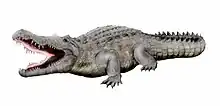| Atacisaurus Temporal range: Middle Eocene, | |
|---|---|
| Scientific classification | |
| Domain: | Eukaryota |
| Kingdom: | Animalia |
| Phylum: | Chordata |
| Class: | Reptilia |
| Clade: | Archosauromorpha |
| Clade: | Archosauriformes |
| Order: | Crocodilia |
| Family: | Gavialidae |
| Genus: | †Atacisaurus Astre, 1931 |
| Species: | †A. glareae |
| Binomial name | |
| †Atacisaurus glareae Astre, 1931 | |
Atacisaurus is an extinct dubious genus of gavialoid crocodylian. Fossils have been found in the Grès de Carcassonne Member of the Sables du Castrais Formation in Laure-Minervois, France that date back to the Middle Eocene.[1]
Discovery and naming
The holotype, discovered in 1919 by M. Finestres in Laure-Minervois and previously housed at the Société d'Etudes Scientifiques de l'Aude,[1] is an anterior portion of a mandible which is now lost,[1] and MHNT.PAL.2012.0.49, a partial skull from a different specimen is also known, which was donated to the History Museum of Toulouse in 1873 by Henri de Sévérac;[2] MHNT.PAL.2012.0.49 has since been partially prepared at sometime between 1931 and 17 April 2016.[1]
The type species, A. glareae, was named and described by Gaston Astre in 1931.[3] A snout fragment from the History Museum of Tolouse was also described by Astre (1931),[3] but can not be identified further than cf. Atacisaurus.[1]
A second nominal species of this genus, Atacisaurus crassiproratus, was reclassified as a sebecosuchian in the 1990s, listed as cf. Iberosuchus by Ortega et al. (1996)[2] before being recognized as distinct from Iberosuchus by Martin et al. (2023) and renamed Dentaneosuchus.[4]
Classification
Atacisaurus glareae has been considered synonymous with Pristichampsus rollinatii,[5] Tomistoma,[6][7] Crocodylus intermedius[8] and Kentisuchus spenceri.[9]
Although currently classified within Gavialidae,[4] Atacisaurus has been suggested to have tentatively belonged within Tomistominae due to its resemblance to Megadontosuchus.[10][11]
References
- 1 2 3 4 5 Jouve, Stéphane (2016). "A new basal tomistomine (Crocodylia, Crocodyloidea) from Issel (Middle Eocene; France): palaeobiogeography of basal tomistomines and palaeogeographic consequences: A New Basal Tomistomine from France". Zoological Journal of the Linnean Society. 177 (1): 165–182. doi:10.1111/zoj.12357.
- 1 2 Ortega, F.; Buscaloni, A.D; Gasaparini, Z. (1996). "Reinterpretation and new denomination of Atacisaurus crassiproratus (Middle Eocene; Issel, France) as cf. Iberosuchus (Crocodylomorpha, Metasuchia)". Geobios. 29 (3): 353–364. doi:10.1016/S0016-6995(96)80037-4.
- 1 2 Astre, G. (1931). "Les crocodiliens fossiles des terrains tertiaires sous pyrénéens". Bulletin de la Société d'Histoire naturelle de Toulouse. 61: 25–71.
- 1 2 Martin, J. E.; Pochat-Cottilloux, Y.; Laurent, Y.; Perrier, V.; Robert, E.; Antoine, P.-O. (2023). "Anatomy and phylogeny of an exceptionally large sebecid (Crocodylomorpha) from the middle Eocene of southern France". Journal of Vertebrate Paleontology. e2193828. doi:10.1080/02724634.2023.2193828. S2CID 258361595.
- ↑ Rossmann, Torsten (1998-11-10). "2. Taxonomical revision of the family Pristichampsidae EFIMOV (Crocodilia: Eusuchia)". Neues Jahrbuch für Geologie und Paläontologie - Abhandlungen. 210 (1): 85–128. doi:10.1127/njgpa/210/1998/85. ISSN 0077-7749.
- ↑ Romer, A. S. (1956). Osteology of Reptiles. Chicago: University of Chicago Press
- ↑ Kuhn, O. (1968) Die vorzeitlichen Krokodile. Munich: Oeben, Krailling bei München.
- ↑ Berg, D. E. (1966) Die Krokodile, insbesondere Asiatosuchus und aff. Sebecus?, aus dem Eozän von Messel bei Darmstadt/Hessen. Abhandlungen des Hessischen Landesamtes für Bodenforschung 52:1-105.
- ↑ Jouve, S. (2004). Etude des Crocodyliformes fini Crétacé-Paléogène du Bassin des Oulad Abdoun (Maroc) et comparaison avec les faunes africaines contemporaines: systématique, phylogénie et paléobiogéographie. Unpublished Ph.D. Dissertation. Paris: Muséum National d'Histoire Naturelle, 651 pp.
- ↑ Vasse, D. (1992).Les crocodiles de l'Aude: aperçu du matériel connu et présentation de quelques nouvelles pièces. Bulletin de la Société d'Etudes Scientifiques de l'Aude. 92: 37–41.
- ↑ Brochu, C. A. (2013). Phylogenetic relationships of Palaeogene ziphodont eusuchians and the status of Pristichampsus Gervais, 1853. Earth and Environmental Science Transactions of the Royal Society of Edinburgh 103: 521–550.


